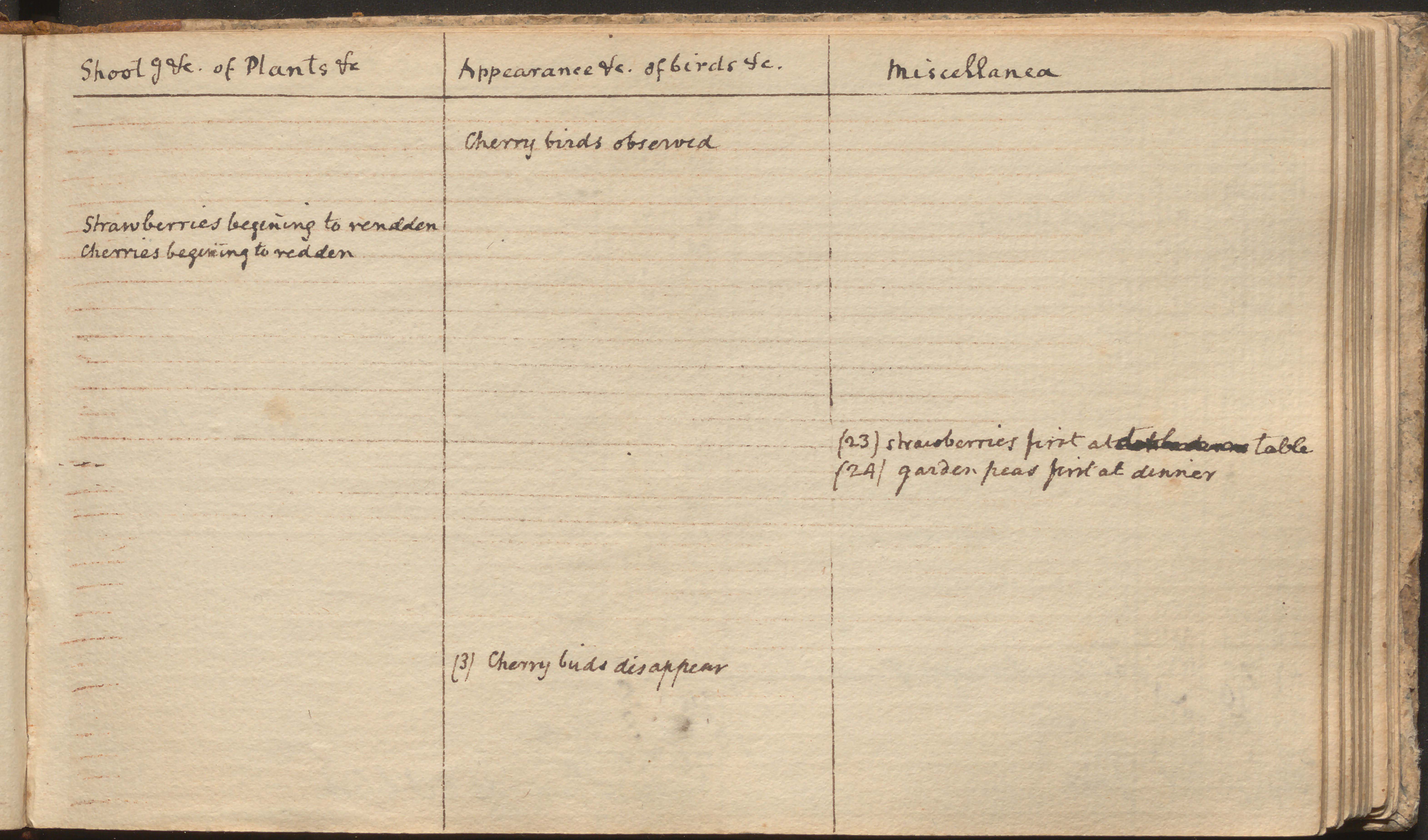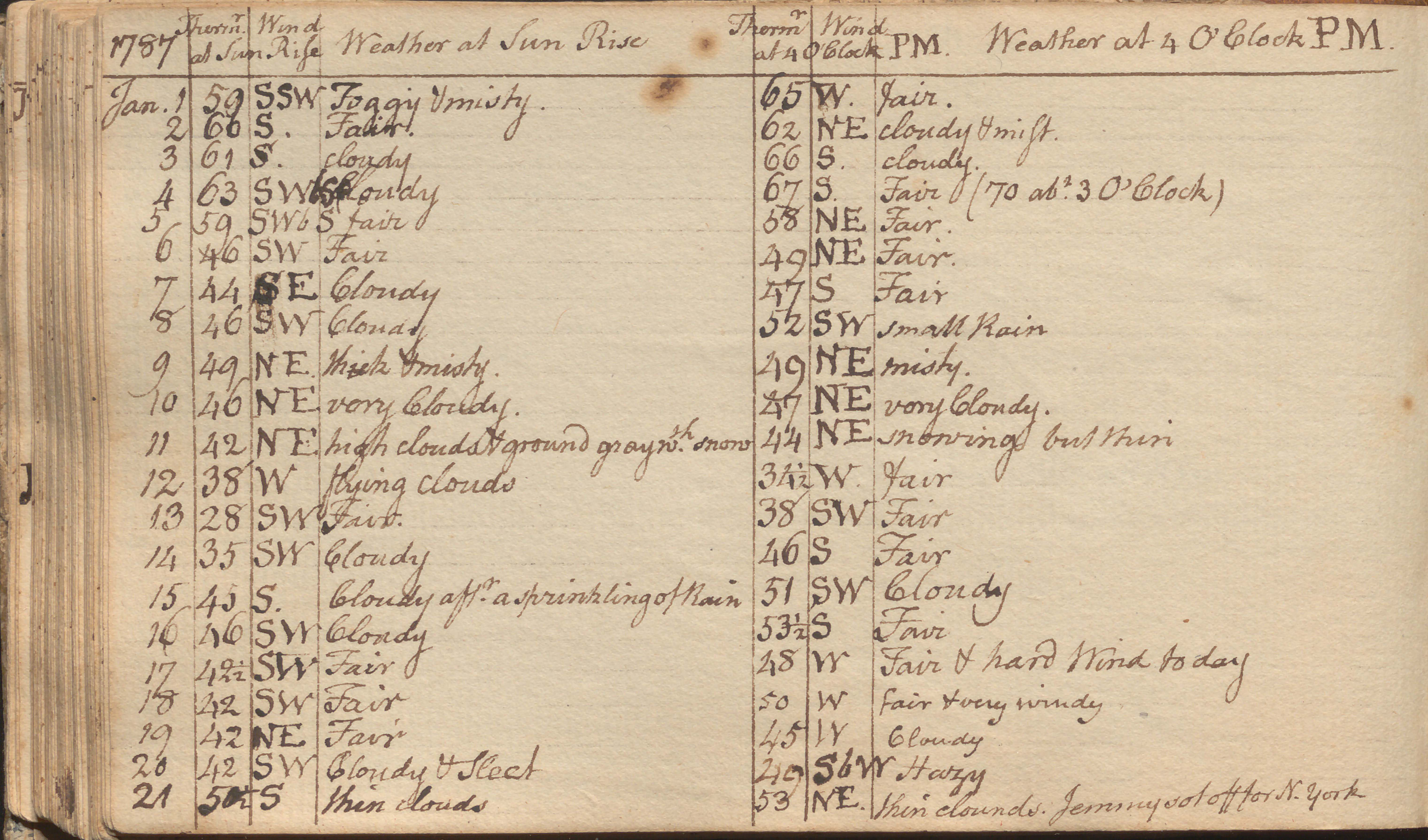Tracing Labor in James Madison’s Meteorological Records
Who made climate records in early America? This question drew me to work with the Madison meteorological records this summer as Martin L. Levitt Fellow as part of the Historic Meteorological Records Project at the Center for Digital Scholarship. The title of the source makes it seem that these records are merely the product of one man—James Madison, a key drafter of the United States Constitution—diligently recording the weather. Yet, as I helped produce a dataset from these records, I found the data revealed the labor of many people besides Madison himself.

The records suggest the important role that slavery played in the Madison family’s everyday life. For example, journal entries every spring from May 23rd, 1786 onward note when strawberries were “first at table,” showing how constant strawberries remained in the Madison family’s taste. But strawberries only appeared “at table” through the careful growing, harvesting, preparing, and serving of strawberries by people the Madisons enslaved. At Montpelier, Madison’s Virginia plantation, the Madisons enslaved over three hundred people. Entries such as “barbacue” on July 11th, 1788 also indicate enslaved people’s culinary labor. Drawing on culinary techniques from West Africa and Indigenous peoples of the Caribbean, enslaved people developed barbecue in the United States, including at Montpelier. This entry testifies to the African diasporic traditions and innovations of enslaved people at Montpelier. These entries referring to strawberries and barbecue testify to slavery’s importance to the weather records’ creation. Because enslaved people fed Madison and grew his crops, Madison had more time to produce the records.
The records also imply that their own creation involved more people than James Madison. An entry on January 21st, 1787 notes that “Jemmy set off for N. York,” which refers to James Madison through his nickname “Jemmy.” A letter from James to his brother Ambrose on February 10th, 1787 corroborates that “Jemmy” was indeed in New York within a few weeks. “Jemmy set off for N. York” hints that another Madison family member produced the meteorological records while James Madison was gone in early 1787—likely James Madison Sr., the younger James’ father. Though James Madison Jr. had started the records, family members like James Madison, Sr. produced data while James Madison Jr. was away, and they exchanged observations in regular letters. The collaboration between father and son hints at the elite family support that enabled James Madison Jr. to achieve his scientific and political accomplishments.

Far from the “great man” James Madison crafting each entry alone, the entries show how these records relied on slavery and familial co-authorship. These entries informed our exhibition highlighting the data and our dataset documentation, but there is much to learn. Reading an entry on August 31st, 1786 that “Sye Died,” I would still like to know who “Sye” was. If the story of “Sye” is like that of enslaved people or “Jemmy,” it will also show how data is entangled in the power relationships that create it. I hope researchers further explore the history of labor recorded in this dataset.
Want to learn more? Check out Joe's digital exhibit, "Have You Ever Seen the Rain?: The 1791 Drought's Damage to Agriculture at Montpelier," part of the Historic Meteorological Project at APS.
This project has been made possible in part by a major grant from the National Endowment for the Humanities: Coronavirus Aid, Relief, and Economic Security Act.
Any views, findings, conclusions, or recommendations expressed in this blog do not necessarily represent those of the National Endowment for the Humanities.
Bibliography
Benjamin, Ruha. Race After Technology: Abolitionist Tools for the New Jim Code. John Wiley & Sons, 2019.
Druckenbrod, Daniel et al. “Late-Eighteenth-Century Precipitation Reconstructions from James Madison’s Montpelier Plantation.” American Meteorological Society, 2003. http://www.meteo.psu.edu/holocene/public_html/shared/articles/Druckenbrod-BAMS03.pdf.
James Madison’s Montpelier, s.v. “Archaeology Sites.” James Madison’s Montpelier, 2020. https://drive.google.com/file/d/0B02-NRxEZl47bG1IVGtXN19XVDg/view.
James Madison’s Montpelier, s.v. "Enslaved Community." James Madison’s Montpelier, 2020. https://www.montpelier.org/learn/tag/enslaved-community.
James Madison’s Montpelier, s.v. “The Life of James Madison.” Jame’s Madison’s Montpelier, 2020. https://www.montpelier.org/learn/the-life-of-james-madison.
Hicks, Hilarie M. "Montpelier's Edible Alphabet." Montpelier's Digital Doorway. James Madison’s Montpelier, December 03, 2019. https://digitaldoorway.montpelier.org/2019/11/27/montpeliers-edible-alphabet/.
Hicks, Hilarie M. "Putting People in the Picture." Montpelier's Digital Doorway. James Madison’s Montpelier, April 9, 2020. https://digitaldoorway.montpelier.org/2020/04/09/putting-people-in-the-picture/.
History Today, s.v. "Is There Still Value in 'Great Man' History?" History Today 69:9 (September 2019). https://www.historytoday.com/archive/head-head/there-still-value-‘great-man’-history.
Madison, James. "From James Madison to Ambrose Madison, 10 February 1787." Founders Online. National Archives and Records Administration. https://founders.archives.gov/documents/Madison/01-09-02-0132.
Twitty, Michael W. "The Colonial Roots of Southern Barbecue: Re-Creating the Birth of An American Culinary Staple." Afroculinaria. July 14, 2012. https://afroculinaria.com/2012/07/14/the-colonial-roots-of-southern-barbecue-re-creating-the-birth-of-an-american-culinary-staple/.
